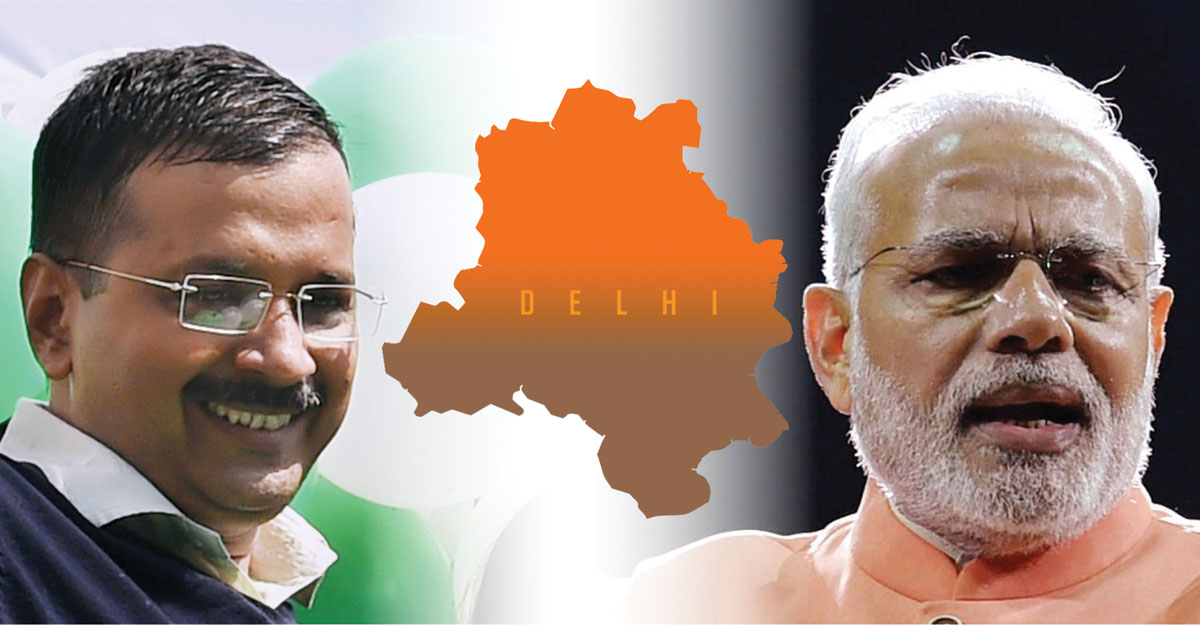COMPETITION IS HEALTHY
Delhi Chief Minister Arvind Kejriwal (l) and Prime Minister Narendra Modi.
Suppose the contest was between Arvind Kejriwal and Narendra Modi to be Delhi’s chief minister. For argument’s sake and to complete the picture, if Rahul Gandhi was in the fray too. Any direct Modi-Kejriwal fixture would have much been closer for sure, though it is risky to make such assessments before hand, as the exit polls demonstrated by getting it wrong yet again. There should be some mechanism to ensure the pollsters refund their fees due to selling products so badly off the mark. They should be made to apologize, at the least, writes Siddharth Srivastava.
It is, however, safe to assume without seeking opinions, that Rahul Gandhi would have lost badly, and probably brushed aside the defeat with a beatific smile as he did following the general elections that angers his party cadres no end nowadays. The latest to lose her patience is Jayanti Natarajan, a veteran Congress leader.
The advent of Kiran Bedi, probably, queered it for the BJP during the recently concluded Delhi elections. Her powerful persona and “I will set things right my way whether you like it or not as I am a Magsaysay winner, towed Indira Gandhi’s car and restructured Tihar Jail,” resulted in Modi being obliterated from the consciousness of Delhi voters. That did not help the BJP.
It helped Kejriwal. Of course, it is very easy to arrive at such conclusions given the benefit of hindsight once the results are out.
This is what BJP chief Amit Shah, who has lost just one electoral matchup so far and that too to Kejriwal who turned out to be no minnow, would probably have us believe. No doubt, India needs both Kejriwal and Modi to succeed, just as India cannot win matches with only Virat Kohli scoring hundreds at a faster rate than Sachin, while the rest, whether Dhawan, Raina or Dhoni, failing.
Competition is healthy. Both Modi and Kejriwal mean business and have been voted to power due to clearly defined promises.
Kejriwal will need to take on corruption at lower levels of government functioning that affects everybody. The poor are the biggest victims while the rich and middle classes need to pay bribes to get their work done. The one index to measure the happiness of Delhi is the mood of the auto rickshaw drivers, the most harassed due to forced inducements to multiple agencies, beginning at the level of a traffic constable. If Kejriwal can make them content, it will be a sure shot indication that corruption has been checked.
The Aaam Aadmi party head, meanwhile, is clearly a mellowed and matured person following his short 49-day stint as chief minister of Delhi earlier and comprehensively losing the general elections last summer to Modi. Thankfully, in the first few days of his second tenure the pre-dominant images have been Kejriwal and his wife out on a leisurely morning walk. He hugged her in front of the cameras following the astonishing victory of his party, though not as passionately as Modi grabbed Obama at the Palam airport tarmac in a show of outright bro-mance. Not sure whether Modi would have appreciated Obama’s parting speech at Siri Fort about respecting all religions. Like any relationship, Modi-Obama, India-USA also has its share of undercurrents.
Kejriwal does look a winner, not an anarchist any more, which is the way it should be. He has set himself a five-year time frame to deliver. Changing any system with vested interests and a super efficient delivery paradigm that thrives on bribes, whether to procure driving license or register property, cannot be an overnight process. Kejriwal will need to show results or else the voters of Delhi and perhaps the rest of the country will shunt him out. If he succeeds, he can be a legitimate challenge to Modi in 2019.
Kejriwal has hurt Modi. But, there is a long battle ahead. Modi is no pushover. His government is pushing for growth and sorting out India’s woeful power supply scenario by promoting clean energy like no Prime Minister has done before.
He has evolved from the days as chief minister of Gujarat when an underlying communal machinery was at work to ply Hindutva as a vote gathering strategy. Modi knows too well the people of India have overwhelmingly backed him to deliver on his promises of development, growth and good governance. One can sense that the Prime Minister’s Office is at work, silently, frenetically and efficiently to ensure that “Make in India” does not remain a mere slogan like Swachh Bharat Abhiyaan, that the country’s natural resources, whether the sun, wind, coal, oil and gas, spectrum, are efficiently managed; that industry and manufacturing prospers. This is not about crony capitalism.
This is about changing the overall picture and the way India is viewed by global investors. The impact of these changes take some time to trickle to the common man; pursued with earnest they will sooner or later take the form of greater income for all. It will be good for India if either Kejriwal or Modi succeed. Given their positive agendas, it will be even better if both do well.


